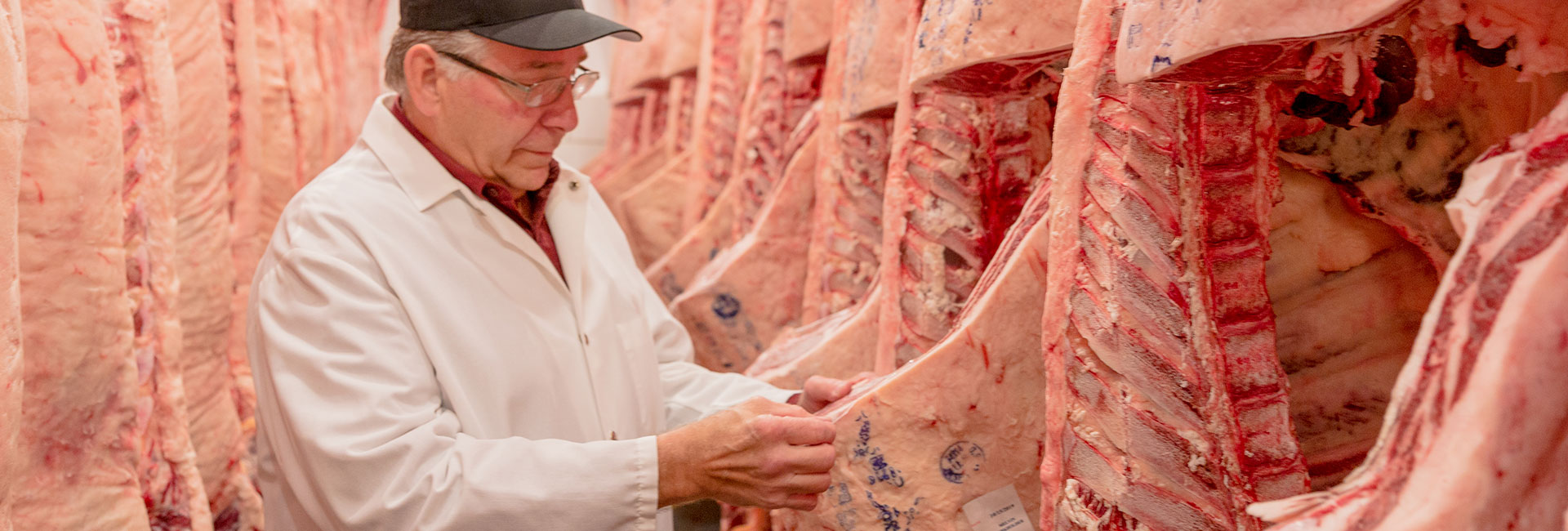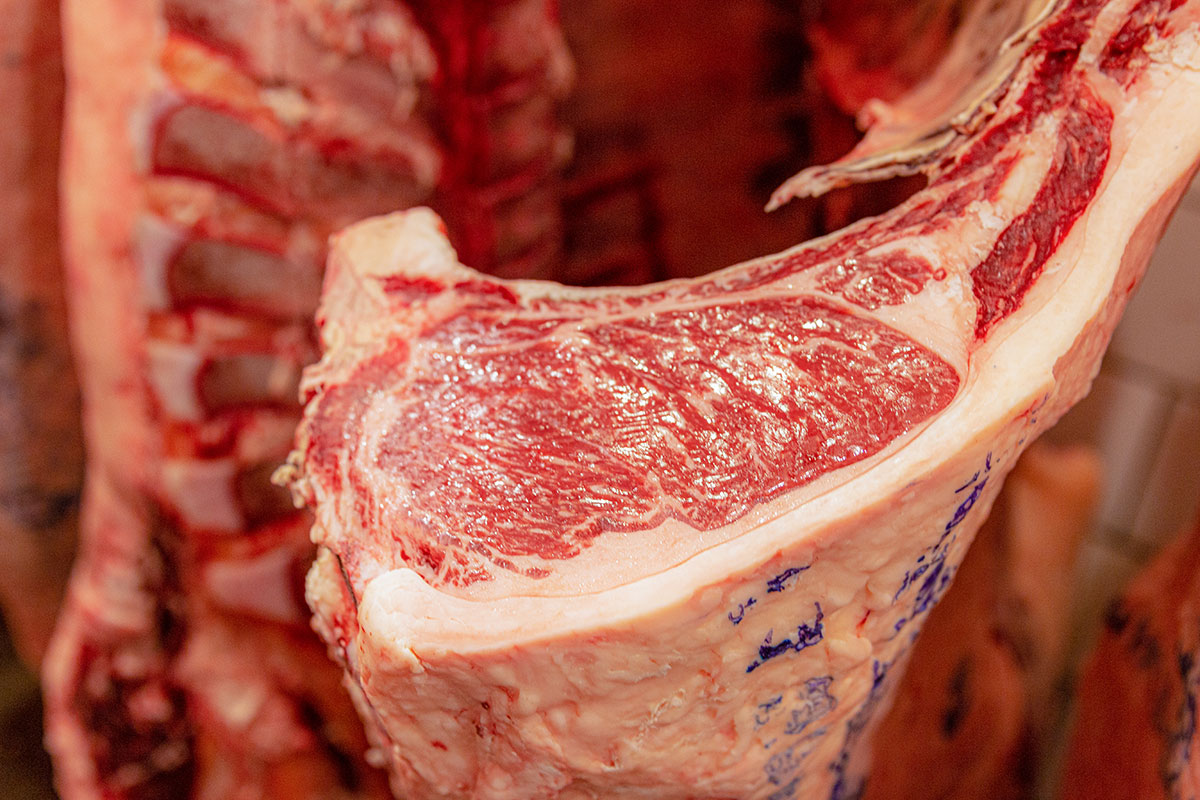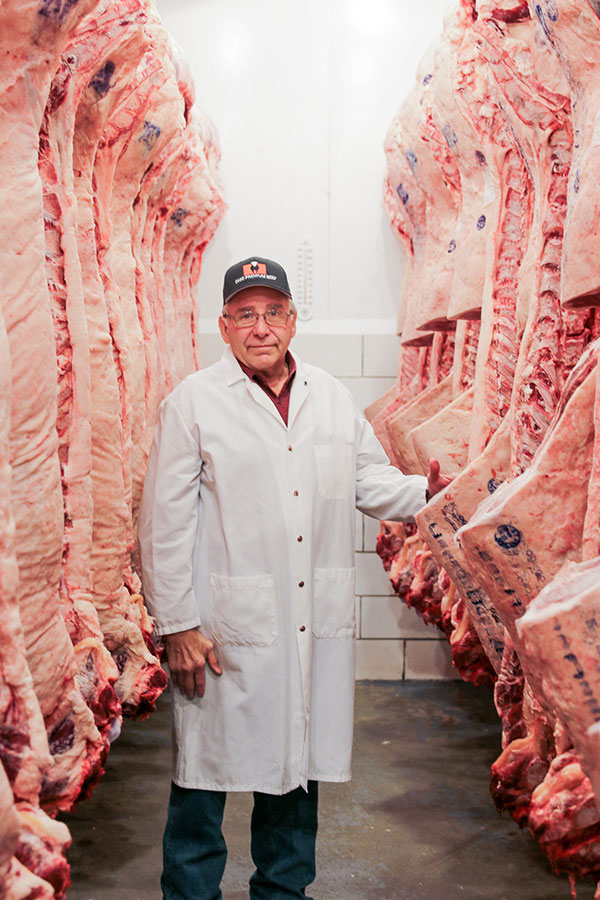
Old-fashioned excellence
Local packer offers unique advantages to worldwide brand
By: Brianna Gwirtz
Half a side of beef glides out of the cooler on an overhead hook, wheel and track line into a small meat lab. A group of chefs gather round; for many, it’s their first time seeing a carcass.
They admire the enormity of it all and make sure to take a look at the amount of marbling in the ribeye. They know that’s the good stuff, the small, white flecks of flavor.
Perhaps what throws the chefs for the biggest loop, however, is the stamped label on the carcass side that features a farm name, a hot carcass weight and a date.
That’s the result of the Certified Angus Beef ® (CAB®) brand’s working relationship with E.R. Boliantz Packing Company, owned and operated by Bob Boliantz and his 50 employees in Ashland, Ohio. Hundreds of guests make their way to the CAB Culinary Center in nearby Wooster every year to learn about the best Angus beef on the market, and one of the highlights is a fabrication lesson. That takes a steady supply of beef to hang on the hook.
“We buy sides of beef weekly from Bob and have been working with him since we opened the center,” meat scientist Diana Clark says.
“Since they have a USDA grader come in every week, we can explain how grading works and can share that packing plant perspective with guests,” she adds. “It’s crazy how phenomenal the quality is. It’s all local, too, which is amazing.”
The packing company is the brand’s smallest licensed plant, but that doesn’t reflect its big impact on business and sales.

It’s who you know
Boliantz sits behind his desk, leafing through some of his father’s old business receipts from 1943, stopping on one in particular.
“Eight head of cattle – $893 … total,” he laughs. “Obviously, my father was a much better buyer than I am.”
Emil Boliantz had a knack for picking the right cattle and knowing which farmers he could count on to supply his Mansfield, Ohio, plant with high-quality beef. The son of butcher shop owners, Emil grew up in the business, turning a youth’s worth of knowledge into a successful meat-packing venture before passing the trade on to his son.
Even after that company was purchased by another meat purveyor, the son chose to stay on, for a while. But as the business direction began to drift from Boliantz’s goals, the family’s past wholesale customers reached out with their need for high-quality beef – and he knew where to get it.
Relationships forged with local farmers were still strong, so Boliantz began sourcing those cattle and processing the beef at various plants in the late 1970s.
“After a day’s work at my father’s former company, I would haul cattle from the country to a local harvest facility for processing,” he recalls. “Then I’d rent a truck and deliver the meat to my wholesale customers in the evening.”
Then, upon leaving that company, Boliantz went into business for himself in 1977. He rented space and harvest floors, continuing to process livestock purchased from local farmers and selling beef to small high-end meat shops. Finally in 1986, he had the opportunity to buy the plant that houses his company today.
“It’s about relationships,” Boliantz says. “If you build relationships with the farmers and with the right people who can help them, you’re going to have the right kind of cattle to work with. I’d argue that relationship building is even more important than the actual meat business.”
Each week, he reviews his ready cattle list and calls on his local producers to secure enough cattle to meet store orders.
“Do you see this?” he says, lifting a small blue notebook. “I update this weekly.”
He points to a name in the well-worn book.
“This farm here is unique. A larger packing plant wants to purchase cattle out of this lot, but the farmer told the buyer he wanted to wait to see what we needed,” Boliantz says with a chuckle. “It’s a good relationship. He could easily send two semi loads out but he wants to make sure he’s got inventory for us to take care of our customers’ specific needs.”
Boliantz mentions another family farm in the tiny village of Shiloh, Ohio.
“This father-son pair here are actually tweaking their feed rations a bit,” he says. “Working to get cattle that grade a little better, to fit our customers’ needs.”
He continues to flip through the notebook with a slight smile on his face, certainly thinking about his friendships with the producers.
“I enjoy sorting cattle and I enjoy sharing information with farmers about what we are looking for in the cattle. It’s also nice to be able to show them their carcasses hanging in the cooler after harvest.”
In his subtle, friendly and humble way, Boliantz has had a big impact on increasing area beef quality.
Quality education
Driving across the Ohio countryside, stopping at feedlots and cow-calf operations, he saw great cattle but knew the farmers could do even better.
“Each and every farmer here in Ohio has a different approach to feeding cattle. We have such a diverse range of cattle feeders, anywhere from a one-man operation feeding just a few to a family partnership feeding hundreds,” Boliantz says. “It has to do with both economics and equipment, Ohio’s not exactly feedlot country. We do things differently here.”
That’s where his partnership with Francis Fluharty, former Ohio State University researcher, now Animal and Dairy Science Department Head at the University of Georgia, came in handy.
They created educational services for Ohio beef farmers.
“Dr. Fluharty helps the farmers with the nutrition and general feeding practices, and then we provide the opportunity for those farmers to see their finished product on the rail.” Boliantz says. “We walk them through the cooler, show them their sides of beef and make recommendations based on both yield and quality grades.”
The opportunity to work one-on-one with area experts has helped with quality consistency in the beef supply at Boliantz.
“In Ohio, most feedlots average 100 to 200 head of cattle,” he says. “Some of them are cow-calf guys but then we have a lot of guys bringing in stockers to feed. Some folks are sourcing cattle from multiple farms because they just don’t raise enough of their own.”
“Our ability to share knowledge with our farmers – based on the relationships with Dr. Fluharty and the Ohio State University – has resulted in a dramatic increase in product quality, allowing us to do a little better job for everybody,” Boliantz says.
The plant only harvests 100 to 125 head a week, but more than half of those cattle qualify for CAB, with 18% hitting Prime grade.
In an area surrounded by a large dairy community, just 57% of the cattle coming in are Angus type.
“We encourage our producers to purchase or raise high-quality feeders that are likely to meet the CAB brand specs because they’re more marketable,” the packer says.

Teaching the next generation
Boliantz is known for doing things the old-fashioned way. Workers wrap the meat in shroud cloth, smoothing out the fat. The company then allows sides to dry-age in the cooler for five to 10 days. The master introduces the old methods to new employees.
“What is the company’s future?” he asks. “Our employees and the relationships that we created with our producers and customers.”
With just over 50 employees working in areas including the harvest floor, the fabrication room and in day-to-day operations like Boliantz’s daughter who is in charge of human resources, the company has grown significantly from its early days.
“The more involved we can get people and the more they learn, the better. That’s my goal – to see the business go on,” he says.
E.R. Boliantz Packing Company sells CAB product into several area retail outlets including a few Giant Eagle stores in Pennsylvania and in markets across northeast Ohio. It also supplies a specialty meat company in Cleveland, which then distributes the product to high-end restaurants and steakhouses, such as the James Beard Award-nominated Greenhouse Tavern in downtown Cleveland.
“It’s really neat to have some of those Cleveland-based chefs and distributors come in to the Culinary Center,” Clark says. “It brings up that discussion of local beef. It’s such a hot topic right now and it’s something a lot of people want to talk about.”
“Local” resonates with salesmen, chefs, restauranteurs and even farmers and ranchers.
“It allows us to explain that beef like what we have in the center is produced by farmers all across the country, and that it’s attainable even by smaller operations. Having high quality no matter where you’re at is achievable,” Clark says.
The Culinary Center, with its mission to further high-quality beef education and drive demand for registered Angus cattle, hosts groups nearly every day of the work-week, year round. It’s focused on building relationships.
A visit almost always includes a stop in that meat lab that’s ever-dependent on the quality relationships Boliantz has built, and the beef that comes from them.
Originally ran in the Angus Journal.
You May Also Like…
$100,000 Up for Grabs with 2024 Colvin Scholarships
Certified Angus Beef is offering $100,000 in scholarships for agricultural college students through the 2024 Colvin Scholarship Fund. Aspiring students passionate about agriculture and innovation, who live in the U.S. or Canada, are encouraged to apply before the April 30 deadline. With the Colvin Scholarship Fund honoring Louis M. “Mick” Colvin’s legacy, Certified Angus Beef continues its commitment to cultivating future leaders in the beef industry.
Raised with Respect™ Cattle Care Campaign Launched This Fall
Raised with Respect™ was developed as part of a strategic cattle care partnership between Sysco and CAB. The collaboration focuses on supporting farmers and ranchers, equipping them with continuing education to stay current on best management practices and helping to increase consumer confidence in beef production.
Certified Angus Beef Celebrates 45th Year with Strong Sales
It has been 45 years since Certified Angus Beef’s first customer purchased a strip steak at Renzetti’s IGA grocery store. Since then, consumer demand for high-quality beef has grown, ultimately driving demand for premium Angus genetics.




